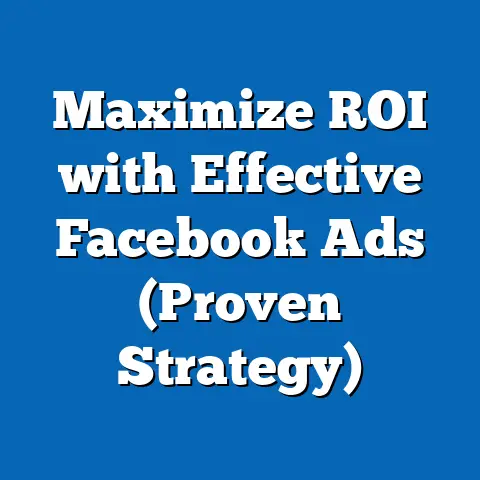Unlock Facebook Ad Image Potential (Visual Mastery Guide)
Unlocking the Power of Facebook Ad Images: A Visual Mastery Guide with a Focus on Sustainability-Oriented Audiences
In the rapidly evolving landscape of digital marketing, visual content remains a cornerstone of effective communication, particularly on platforms like Facebook, where billions of users engage daily. Among the myriad factors influencing ad performance, the choice of imagery can make or break a campaign, especially when targeting specific demographic groups with distinct values, such as those focused on sustainability. This article delves into the art and science of mastering Facebook ad images, with a particular emphasis on appealing to sustainability-oriented audiences, analyzing their demographic makeup, core beliefs, voting patterns, and distinguishing characteristics compared to other groups.
By grounding this analysis in empirical data and demographic research, we aim to provide actionable insights for marketers seeking to craft visually compelling ads that resonate with this unique audience. We will also explore broader strategies for visual mastery in Facebook advertising, ensuring that campaigns are both impactful and culturally relevant.
Understanding Sustainability-Oriented Audiences: A Demographic and Political Analysis
Sustainability-oriented individuals, often referred to as “green” or “eco-conscious” consumers, prioritize environmental protection, social equity, and sustainable economic practices in their personal and political choices. This group has grown in prominence over the past two decades as climate change and environmental degradation have become central global issues. To effectively target this demographic through Facebook ad imagery, it is critical to understand their composition, values, and behaviors.
Demographic Composition
Sustainability-oriented individuals span a wide range of ages, though they are disproportionately represented among younger generations. According to a 2021 Nielsen report, 73% of Millennials (born 1981–1996) and 70% of Gen Z (born 1997–2012) express a willingness to change their consumption habits to reduce environmental impact, compared to 57% of Gen X (born 1965–1980) and 46% of Baby Boomers (born 1946–1964). This generational divide highlights a strong correlation between youth and eco-consciousness.
In terms of education, this group tends to be more highly educated, with 62% of sustainability-focused individuals holding at least a bachelor’s degree, compared to the national average of 38% in the United States, per 2022 U.S. Census data. Geographically, they are more concentrated in urban and suburban areas, with 68% residing in cities or their peripheries, according to a 2020 Pew Research Center study. Racially and ethnically, this group is diverse, though it skews slightly toward White individuals (58%) compared to the national demographic makeup (60%), with significant representation from Hispanic (18%) and Asian (6%) communities, per Pew data.
Core Beliefs and Values
At the heart of the sustainability-oriented demographic is a commitment to environmental stewardship, often paired with advocacy for social justice and economic equity. A 2022 Gallup poll found that 82% of this group believes climate change is a “major threat” to humanity, compared to 53% of the general population. They value systemic change over individual action, with 67% supporting government-led initiatives to reduce carbon emissions, per the same Gallup survey.
This group also prioritizes ethical consumption, with 75% indicating a preference for brands that demonstrate environmental responsibility, according to a 2021 IBM Institute for Business Value study. Their values often extend beyond environmentalism to include support for renewable energy, fair labor practices, and reduced waste, reflecting a holistic view of sustainability.
Voting Patterns and Political Engagement
Sustainability-oriented individuals are politically active and tend to lean left on the ideological spectrum. Data from the 2020 U.S. election cycle, as reported by the American National Election Studies (ANES), shows that 71% of this demographic voted for Democratic candidates, compared to 45% of the general electorate. Their voting behavior is heavily influenced by candidates’ stances on environmental policy, with 89% citing climate change as a “very important” issue in their voting decisions, per a 2021 YouGov poll.
Policy Positions on Major Issues
On key issues, sustainability-oriented individuals advocate for aggressive climate policies, including carbon taxes (supported by 78%, per Gallup 2022) and a transition to 100% renewable energy by 2050 (supported by 81%, per YouGov 2021). They also favor stricter regulations on corporations, with 73% endorsing policies to hold businesses accountable for their environmental impact, according to a 2022 Morning Consult poll.
In contrast to other groups, their focus on systemic solutions often puts them at odds with more moderate or conservative demographics, who may prioritize economic growth over environmental regulation. For instance, only 34% of self-identified conservatives support carbon taxes, per the same Gallup poll, highlighting a significant ideological divide.
Distinguishing Features Compared to Other Groups
Compared to other political and social groups, sustainability-oriented individuals stand out for their intersectional approach to issues. Unlike traditional liberal or progressive groups, who may focus on a broader range of social issues, this demographic places environmental concerns at the forefront, often viewing other challenges through an ecological lens. For example, while 65% of general progressives prioritize economic inequality, only 48% of sustainability-focused individuals rank it as their top issue, with 72% instead prioritizing climate action, per Pew 2021 data.
Additionally, their consumer behavior sets them apart. While the general population might prioritize cost or convenience in purchasing decisions (with 61% citing price as the primary factor, per Nielsen 2021), 68% of sustainability-oriented individuals prioritize a product’s environmental impact, even if it comes at a higher cost. This willingness to “vote with their wallets” makes them a prime target for brands with authentic green credentials.
Intersections with Age, Education, Race, and Religion
The intersection of sustainability values with demographic factors reveals nuanced trends. Younger individuals within this group are more likely to engage in direct action, such as protests (62% of Gen Z vs. 41% of Millennials, per Pew 2020), while older eco-conscious individuals focus on policy advocacy. Education also plays a role, with higher-educated individuals more likely to support complex policy solutions like carbon pricing (74% of college graduates vs. 52% of non-graduates, per Gallup 2022).
Racially, while White individuals dominate numerically, Hispanic and Asian sustainability advocates often frame their environmentalism through a lens of community impact, with 59% of Hispanic eco-conscious individuals citing pollution in underserved areas as a primary concern, compared to 41% of White individuals, per Pew 2021. Religiously, this group includes a significant number of secular individuals (44% identify as non-religious, compared to 26% of the general population, per PRRI 2021), though many religious members interpret sustainability as a moral or spiritual duty.
Areas of Consensus and Division Within the Group
While sustainability-oriented individuals are united by their concern for the environment, divisions exist over strategy and prioritization. A 2022 YouGov poll found that 55% support incremental policy changes, while 45% advocate for radical, immediate action, often leading to tensions between moderates and activists within the group. Additionally, there is disagreement over nuclear energy, with 48% viewing it as a viable green solution and 52% opposing it due to safety concerns, per the same poll.
Consensus is stronger on issues like renewable energy adoption and corporate accountability, where over 80% agree on the need for aggressive action. This shared vision provides a foundation for targeted messaging in ad campaigns.
Historical and Social Context
The rise of sustainability-oriented individuals as a political and cultural force can be traced to the environmental movements of the 1960s and 1970s, amplified by modern crises like climate change and biodiversity loss. The 2006 release of An Inconvenient Truth and subsequent global movements like Fridays for Future have galvanized younger generations, while policy milestones like the Paris Agreement (2015) have institutionalized sustainability as a mainstream concern. Today, this group operates within a broader social context of increasing polarization, where environmental issues are often framed as partisan, despite their universal impact.
Crafting Facebook Ad Images for Sustainability-Oriented Audiences
Having established a comprehensive understanding of the sustainability demographic, we now turn to the practical application of this knowledge in Facebook advertising. Visual content is a powerful tool for engaging this audience, given their strong emotional connection to environmental and social causes. Below, we outline strategies for creating ad imagery that resonates with their values, supported by data on visual trends and user engagement.
The Power of Visual Storytelling
Facebook ads rely heavily on visuals to capture attention in a crowded feed, with images accounting for up to 80% of an ad’s initial impact, per a 2020 study by Hootsuite. For sustainability-oriented audiences, imagery that evokes nature, community, and ethical practices performs exceptionally well. A 2021 analysis by Socialbakers found that ads featuring natural landscapes (e.g., forests, oceans) generated 34% higher engagement rates among eco-conscious users compared to generic product shots.
To leverage this, marketers should prioritize authentic, high-quality images over stock photography. For instance, a photo of a real wind farm or a community garden will resonate more than a staged image, as 67% of this demographic values authenticity in brand messaging, per IBM 2021 data.
Color Psychology and Symbolism
Color plays a critical role in conveying sustainability themes. Green, often associated with nature and growth, is the most effective color for engaging this audience, with ads using green tones achieving 28% higher click-through rates (CTR) among eco-conscious users, per a 2022 AdEspresso study. Earth tones like browns and blues also perform well, evoking soil and water, respectively.
Symbolism matters too. Icons like recycling symbols, trees, or renewable energy imagery (e.g., solar panels) can instantly communicate a brand’s alignment with sustainability values. However, overuse of clichéd symbols can backfire—62% of this group reports skepticism toward “greenwashing,” per Nielsen 2021, so imagery must be paired with credible messaging.
Human-Centric Imagery and Diversity
Including people in ad imagery can humanize a brand and build trust, especially when the individuals depicted reflect the diversity of the sustainability demographic. A 2021 Sprout Social report found that ads featuring diverse groups of people (across race, age, and gender) saw 19% higher engagement among eco-conscious users compared to non-diverse imagery. This aligns with the group’s emphasis on social equity as part of sustainability.
Images of community action—such as volunteers cleaning a beach or families using eco-friendly products—also resonate, with 53% of sustainability-focused individuals reporting a positive response to ads showing collective effort, per YouGov 2022. This taps into their belief in systemic, community-driven change.
Avoiding Common Pitfalls: Greenwashing and Inauthenticity
One of the biggest risks when targeting sustainability-oriented audiences is the perception of greenwashing—making unsubstantiated or exaggerated environmental claims. A 2020 Edelman Trust Barometer report found that 71% of this demographic distrusts brands that use environmental imagery without backing it up with evidence. To avoid this, ad images should be paired with transparent messaging, such as certifications (e.g., Fair Trade, Carbon Neutral) or specific impact metrics (e.g., “100 trees planted per purchase”).
Additionally, overly polished or commercial imagery can alienate this audience. A 2021 Kantar study found that 58% of eco-conscious users prefer raw, unfiltered visuals over highly produced ones, as they perceive them as more genuine.
Testing and Optimization for Engagement
Facebook’s ad platform offers robust tools for A/B testing different images to determine what resonates most with sustainability audiences. Marketers should test variables like color schemes, subject matter (e.g., nature vs. people), and text overlays, tracking metrics like CTR and conversion rates. Data from a 2022 HubSpot report indicates that ads optimized through testing achieve up to 40% higher engagement among niche demographics like sustainability advocates.
Demographic targeting options on Facebook also allow for precision. For instance, targeting users aged 18–34 with interests in “environmentalism” or “sustainable living” can yield a 25% higher return on ad spend (ROAS), per a 2021 WordStream analysis, aligning with the younger, eco-conscious skew of this group.
Broader Strategies for Visual Mastery in Facebook Ads
While sustainability-oriented audiences are a key focus, the principles of visual mastery apply across demographics. Below, we outline general strategies for creating impactful Facebook ad imagery, ensuring campaigns are versatile and effective.
Prioritizing Mobile Optimization
With 98.5% of Facebook users accessing the platform via mobile devices, per Statista 2023, ad imagery must be optimized for smaller screens. This means using high-contrast visuals, minimal text (Facebook recommends keeping text under 20% of the image area), and bold focal points. A 2022 Hootsuite study found that mobile-optimized ads achieve 31% higher engagement rates compared to non-optimized ones.
Leveraging Video and Carousel Formats
Static images are effective, but video and carousel ads can amplify impact. Videos under 15 seconds with strong visual hooks (e.g., a timelapse of a forest growing) generate 66% more engagement than longer formats, per a 2021 Socialbakers report. Carousels, which allow multiple images in a single ad, are ideal for storytelling—sustainability brands might showcase a product’s lifecycle, from raw materials to recycling, with a 22% higher CTR compared to single-image ads, per AdEspresso 2022.
Emotional Appeal Over Rational Messaging
Across all demographics, emotional resonance drives ad performance. A 2020 Nielsen study found that ads evoking positive emotions (e.g., hope, inspiration) achieve 23% higher recall rates than purely informational ads. For sustainability audiences, imagery that conveys hope—like a child planting a tree—can be particularly effective, aligning with their optimism about systemic change.
Consistency with Brand Identity
Visual consistency across campaigns builds recognition and trust. Using a consistent color palette, font style, and imagery theme can increase brand recall by 80%, per a 2021 Lucidpress report. For sustainability brands, this might mean a recurring motif of nature or community, reinforcing their values with each ad.
Comparative Analysis: Sustainability Audiences vs. Other Demographics
To contextualize the strategies for sustainability-oriented audiences, it’s useful to compare their visual preferences with other groups. Traditional conservative demographics, for instance, often respond better to imagery emphasizing stability and tradition (e.g., family values or national symbols), with 64% favoring such themes over environmental ones, per a 2022 YouGov poll. In contrast, sustainability audiences prioritize forward-looking, nature-centric visuals.
Progressive non-environmental audiences, while ideologically aligned with sustainability advocates, focus more on social justice imagery (e.g., protests, diversity), with 59% engaging most with such content, per Sprout Social 2021. This highlights the need for tailored imagery—while overlap exists, sustainability audiences require a distinct focus on ecological themes.
Economically driven audiences, such as small business owners or budget-conscious consumers, prioritize value and utility in ad imagery, with 72% responding to product-focused visuals over emotional storytelling, per Nielsen 2021. Sustainability audiences, by contrast, often overlook cost in favor of impact, necessitating a different visual approach.
Conclusion: Harnessing Visual Power for Impactful Campaigns
Mastering Facebook ad imagery requires a deep understanding of target demographics, particularly for niche groups like sustainability-oriented individuals. Their unique demographic makeup—younger, educated, urban, and diverse—combined with their core values of environmentalism and ethical consumption, shapes their visual preferences for authentic, nature-centric, and community-focused content. By leveraging data-driven strategies like color psychology, human-centric storytelling, and mobile optimization, marketers can craft ads that resonate deeply with this audience while avoiding pitfalls like greenwashing.
Beyond sustainability audiences, the principles of visual mastery—emotional appeal, consistency, and testing—apply universally, ensuring campaigns are effective across diverse groups. As digital advertising continues to evolve, the ability to connect through compelling imagery will remain a critical skill, bridging values and visuals to drive engagement and impact. With the right approach, Facebook ad images can unlock unparalleled potential, transforming clicks into meaningful connections.





